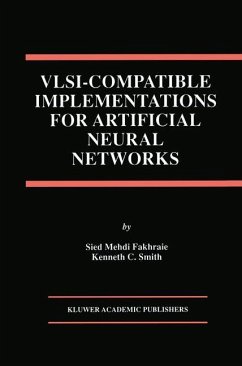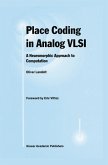VLSI-Compatible Implementations for Artificial Neural Networks introduces the basic premise of the authors' approach to biologically-inspired and VLSI-compatible definition, simulation, and implementation of artificial neural networks. In addition, the book develops a set of guidelines for general hardware implementation of ANNs. These guidelines are then used to find solutions for the usual difficulties encountered in any potential work, and as guidelines by which to reach the best compromise when several options exist. Furthermore, system-level consequences of using the proposed techniques in future submicron technologies with almost-linear MOS devices are discussed.
While the major emphasis in this book is to develop neural networks optimized for compatibility with their implementation media, the work has also been extended to the design and implementation of a fully-quadratic ANN based on the desire to have network definitions epitomized for both efficient discrimination of closed-boundary circular areas and ease of implementation in a CMOS technology.
VLSI-Compatible Implementations for Artificial Neural Networks implements a comprehensive approach which starts with an analytical evaluation of specific artificial networks. This provides a clear geometrical interpretation of the behavior of different variants of these networks. In combination with the guidelines developed towards a better final implementation, these concepts have allowed the authors to conquer various problems encountered and to make effective compromises. Then, to facilitate the investigation of the models needed when more difficult problems must be faced, a custom simulating program for various cases is developed. Finally, in order to demonstrate the authors' findings and expectations, several VLSI integrated circuits have been designed, fabricated, and tested.
VLSI-Compatible Implementations for Artificial Neural Networksm> serves as an excellent reference source and may be used as a text for advanced courses on the subject.
This book introduces several state-of-the-art VLSI implementations of artificial neural networks (ANNs). It reviews various hardware approaches to ANN implementations: analog, digital and pulse-coded. The analog approach is emphasized as the main one taken in the later chapters of the book. The area of VLSI implementation of ANNs has been progressing for the last 15 years, but not at the fast pace originally predicted. Several reasons have contributed to the slow progress, with the main one being that VLSI implementation of ANNs is an interdisciplinaly area where only a few researchers, academics and graduate students are willing to venture. The work of Professors Fakhraie and Smith, presented in this book, is a welcome addition to the state-of-the-art and will greatly benefit researchers and students working in this area. Of particular value is the use of experimental results to backup extensive simulations and in-depth modeling. The introduction of a synapse-MOS device is novel. The book applies the concept to a number of applications and guides the reader through more possible applications for future work. I am confident that the book will benefit a potentially wide readership. M. I. Elmasry University of Waterloo Waterloo, Ontario Canada Preface Neural Networks (NNs), generally defined as parallel networks that employ a large number of simple processing elements to perform computation in a distributed fashion, have attracted a lot of attention in the past fifty years. As the result. many new discoveries have been made.
While the major emphasis in this book is to develop neural networks optimized for compatibility with their implementation media, the work has also been extended to the design and implementation of a fully-quadratic ANN based on the desire to have network definitions epitomized for both efficient discrimination of closed-boundary circular areas and ease of implementation in a CMOS technology.
VLSI-Compatible Implementations for Artificial Neural Networks implements a comprehensive approach which starts with an analytical evaluation of specific artificial networks. This provides a clear geometrical interpretation of the behavior of different variants of these networks. In combination with the guidelines developed towards a better final implementation, these concepts have allowed the authors to conquer various problems encountered and to make effective compromises. Then, to facilitate the investigation of the models needed when more difficult problems must be faced, a custom simulating program for various cases is developed. Finally, in order to demonstrate the authors' findings and expectations, several VLSI integrated circuits have been designed, fabricated, and tested.
VLSI-Compatible Implementations for Artificial Neural Networksm> serves as an excellent reference source and may be used as a text for advanced courses on the subject.
This book introduces several state-of-the-art VLSI implementations of artificial neural networks (ANNs). It reviews various hardware approaches to ANN implementations: analog, digital and pulse-coded. The analog approach is emphasized as the main one taken in the later chapters of the book. The area of VLSI implementation of ANNs has been progressing for the last 15 years, but not at the fast pace originally predicted. Several reasons have contributed to the slow progress, with the main one being that VLSI implementation of ANNs is an interdisciplinaly area where only a few researchers, academics and graduate students are willing to venture. The work of Professors Fakhraie and Smith, presented in this book, is a welcome addition to the state-of-the-art and will greatly benefit researchers and students working in this area. Of particular value is the use of experimental results to backup extensive simulations and in-depth modeling. The introduction of a synapse-MOS device is novel. The book applies the concept to a number of applications and guides the reader through more possible applications for future work. I am confident that the book will benefit a potentially wide readership. M. I. Elmasry University of Waterloo Waterloo, Ontario Canada Preface Neural Networks (NNs), generally defined as parallel networks that employ a large number of simple processing elements to perform computation in a distributed fashion, have attracted a lot of attention in the past fifty years. As the result. many new discoveries have been made.








